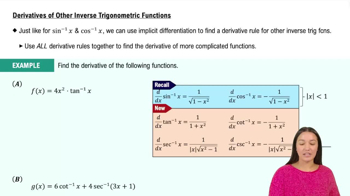Evaluate the expression.
Table of contents
- 0. Functions7h 54m
- Introduction to Functions16m
- Piecewise Functions10m
- Properties of Functions9m
- Common Functions1h 8m
- Transformations5m
- Combining Functions27m
- Exponent rules32m
- Exponential Functions28m
- Logarithmic Functions24m
- Properties of Logarithms36m
- Exponential & Logarithmic Equations35m
- Introduction to Trigonometric Functions38m
- Graphs of Trigonometric Functions44m
- Trigonometric Identities47m
- Inverse Trigonometric Functions48m
- 1. Limits and Continuity2h 2m
- 2. Intro to Derivatives1h 33m
- 3. Techniques of Differentiation3h 18m
- 4. Applications of Derivatives2h 38m
- 5. Graphical Applications of Derivatives6h 2m
- 6. Derivatives of Inverse, Exponential, & Logarithmic Functions2h 37m
- 7. Antiderivatives & Indefinite Integrals1h 26m
- 8. Definite Integrals4h 44m
- 9. Graphical Applications of Integrals2h 27m
- 10. Physics Applications of Integrals 3h 16m
- 11. Integrals of Inverse, Exponential, & Logarithmic Functions2h 31m
- 12. Techniques of Integration7h 41m
- 13. Intro to Differential Equations2h 55m
- 14. Sequences & Series5h 36m
- 15. Power Series2h 19m
- 16. Parametric Equations & Polar Coordinates7h 58m
0. Functions
Inverse Trigonometric Functions
Problem 82
Textbook Question
Evaluating inverse trigonometric functions Without using a calculator, evaluate the following expressions.
tan(tan−11)
 Verified step by step guidance
Verified step by step guidance1
Understand the problem: We need to evaluate \( \tan(\tan^{-1}(1)) \). This involves the inverse trigonometric function \( \tan^{-1} \), which is the inverse of the tangent function.
Recall the definition of \( \tan^{-1}(x) \): It is the angle \( \theta \) such that \( \tan(\theta) = x \) and \( \theta \) is in the range \(-\frac{\pi}{2} < \theta < \frac{\pi}{2} \).
Apply the definition to \( \tan^{-1}(1) \): We need to find an angle \( \theta \) such that \( \tan(\theta) = 1 \). The angle \( \theta \) that satisfies this within the range is \( \frac{\pi}{4} \), because \( \tan(\frac{\pi}{4}) = 1 \).
Substitute back into the original expression: Now that we know \( \tan^{-1}(1) = \frac{\pi}{4} \), we substitute this into the expression to get \( \tan(\frac{\pi}{4}) \).
Evaluate \( \tan(\frac{\pi}{4}) \): Since \( \tan(\frac{\pi}{4}) = 1 \), the expression \( \tan(\tan^{-1}(1)) \) simplifies to 1.
 Verified video answer for a similar problem:
Verified video answer for a similar problem:This video solution was recommended by our tutors as helpful for the problem above
Video duration:
1mPlay a video:
Was this helpful?
Key Concepts
Here are the essential concepts you must grasp in order to answer the question correctly.
Inverse Trigonometric Functions
Inverse trigonometric functions, such as an^{-1}(x), are used to find the angle whose tangent is x. These functions essentially reverse the action of the standard trigonometric functions. For example, if an( heta) = x, then heta = an^{-1}(x). Understanding these functions is crucial for evaluating expressions involving angles and their corresponding trigonometric ratios.
Recommended video:

Derivatives of Other Inverse Trigonometric Functions
Function Composition
Function composition involves applying one function to the result of another function. In the expression an( an^{-1}(1)), the an^{-1}(1) computes the angle whose tangent is 1, which is
rac{ ext{π}}{4} radians. Then, applying the tangent function to this angle returns the original input, demonstrating that an( an^{-1}(x)) = x for all x in the domain of the inverse function.
Recommended video:

Evaluate Composite Functions - Special Cases
Trigonometric Values
Trigonometric values are the outputs of trigonometric functions for specific angles. For instance, an(
rac{ ext{π}}{4}) equals 1, as the tangent of 45 degrees (or
rac{ ext{π}}{4} radians) is 1. Knowing the standard values of trigonometric functions for common angles (0,
rac{ ext{π}}{6},
rac{ ext{π}}{4},
rac{ ext{π}}{3}, and
rac{ ext{π}}{2}) is essential for quickly evaluating expressions without a calculator.
Recommended video:

Introduction to Trigonometric Functions
Related Videos
Related Practice
Multiple Choice


